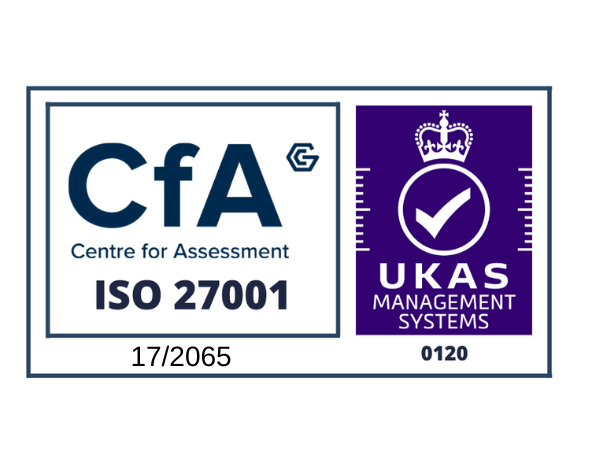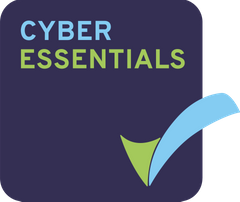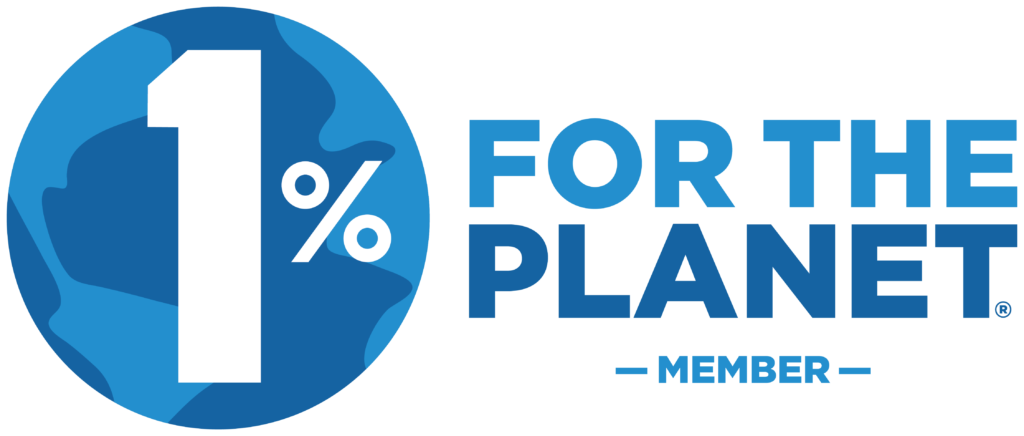There are multiple ways in which to upload and download to and from Projectfusion this article will explain all of them for you.
Upload Limit
LARGE!
The limits are 2Gb for each of the upload methods below:
- Browser upload
- Drag and drop
- Using WebDAV (tools like GoodSync etc)
Uploading
1 – Drag & Drop
This is the easiest way to upload.
- Go to the Document Library.
- Now from your local computer drag 1 or more files or folders onto the screen, and drop them to begin the upload.
- Click OK to complete the upload.
*When dragging and dropping folders, any subfolders and files within will also be uploaded and the folder structure will be maintained in the document library.
If the name of your folder or file contains any of the following characters, the upload will fail.
? ” * < > ? / : |
2 – Upload Button
This method is designed for when drag and drop are not supported.
- Go to the Document Library.
- Click the “Upload” button near the top of the screen.
- Click the magnifying glass icon and select a file from your local computer.
- When ready click Upload to start uploading the file.
- When complete click OK to finish.
- Repeat step 2 for other files.
3 – GoodSync (Bulk Uploading)
You can use 3rd party tools like Goodsync to automatically copy folders from your PC or network drive.
Uploading files places high loads on the server. To minimise any server slowdown, we suggest you run no more than 2 concurrent upload threads, and limit uploads to 100 kilobytes/sec (approx 0.75Mb)
Daily all day uploads? Ask us to quote for a dedicated upload server.
To set it up:
Get a copy of Goodsync there are two versions available the first is free and limits you to 3 Jobs and 100 Files, the second is paid and is completely unlimited this costs $30 and is for 5 devices.
Before setting up the GoodSync application create a brand new “Contributor” user to upload documents. Avoid using a Manager to reduce the risk of accidental deletions!
To start a new job, press ‘Create a New Job’ at the bottom of the window.
Once the ‘New GoodSync Job’ window is open, enter your desired job name and select ‘Backup’ as your job type. We recommend you use ‘Backup‘ mode at all times!
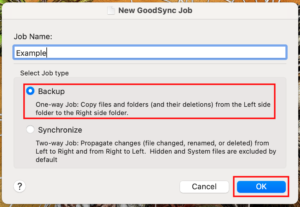
Now you need to tell Goodsync which folder on your PC and which folder on PROJECTFUSION to connect to.
Click the left folder button from the right hand side of the top menu bar. This opens the Left Folder window, where you can choose your upload source. Navigate through your local machine or network to tell GoodSync where you want to upload files from. The screenshot below show the ‘Desktop’ folder selected.
This tutorial assumes you are using goodsync to UPLOAD content. For download/backups the left hand side needs to be the Dataroom/Webdav connection – ask us for help setting up.
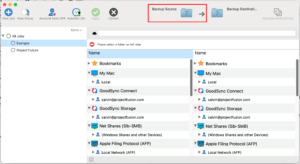
Next, click the right folder button from the right hand side of the top menu bar. This opens the Right Folder window, where you can choose your upload destination.
Scroll down the list to find WebDAV and click the ‘add user’ icon to the right side of the list. This will open the new WebDAV account pop up window.
Now enter the Server Address* and WebDAV root (see example below) and your usual account username and password. Make sure you type https (note the S) and tick “Secure Mode” under the Advanced Options (click the arrow to drop the menu down).
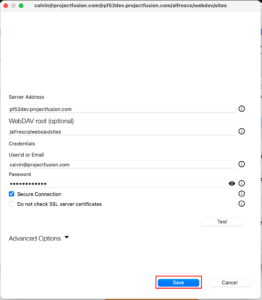
The address must look like this
*Address – https://YOURROOM.projectfusion.com (make sure you type this exactly and replace the YOURROOM with the correct name)
The WebDAV root is not optional and MUST be the following – /alfresco/webdav
IMPORTANT! — For downloads we strongly recommend you use the new “Consumer” user as they don’t have permission to write or delete files. Ask if unsure!
After entering the username, password and address click Save to save your WebDav details.
Goodsync will now try to connect to the data room using the details you entered. If you have token authentication on your user account, you’ll need to login to the web interface before goodsync will connect.
After connecting you’ll see a panel of folders appear below, simply click into the “Sites” folder, then again into the appropriate site, and finally single left click the “documentLibrary” folder to select it as the download source. If you wish to download from a specific folder drill down further and highlight that instead of the documentLibrary.
With both the left and right folders both selected, click the green ‘Apply’ button at the top to save the configuration.
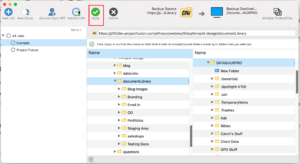
*** CRITICAL STEP ***
We need to turn off Propagate Deletions and stop it storing a system file on the left and right sides. See steps below.
Click Options from the top right corner of the Goodsync window to open the Options pop up.
Under the tab called “General”, you will need to UNCHECK the box named “Propagate Deletions” as outlined in red in the image below. Also make sure the backup is still from left to right.
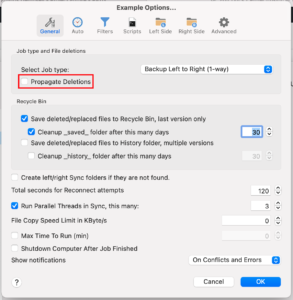
Then, in BOTH the “Left Side” and “Right Side” tabs, UNCHECK the “Safe Copy using temporary files” box and CHECK the “No _gsdata_ folder here” box as outlined in red in the image below. When you have done all this, click the “OK” button in the bottom right of the window.
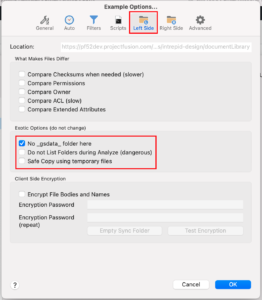
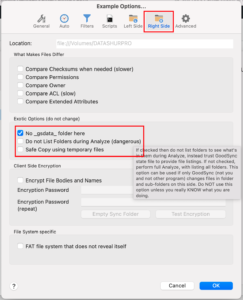
That’s it. Whenever you want goodsync to synchronise the folders, press Analyse, then press Sync to upload.
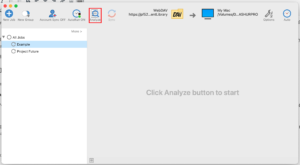
You will almost certainly find that some files do not copy up, goodsync will tell you which ones. This is usually because they’re too large, or have characters our service cannot use.
Downloading
You can use 3rd party tools like Goodsync to copy data from a Projectfusion data room.
A note of caution:
Using sync software like GoodSync is dangerous – a misconfiguration could delete your data.
To download data safely we highly recommend you set up and use a “Consumer” (download only) account.
Setup Guide
Firstly, download the latest copy of Goodsync (there is a trial available) and install and open it.
To start a new job, press ‘Create a New Job’ at the bottom of the window.
Once the ‘New GoodSync Job’ window is open, enter your desired job name and select ‘Backup’ as your job type. We recommend you use the ‘Backup‘ mode at all times!
(Now you need to tell Goodsync which folder on your PC and which folder on PROJECTFUSION to connect to.)
Click the left folder on the top bar (#1 in the screenshot) then scroll down the list and find WebDAV and click the ‘add user’ icon to the right side of the list.
Now enter the Server Address* and WebDAV root (see example below) and your usual account username and password. Make sure you type HTTPS (note the S) and tick “Secure Mode” under the Advanced Options (click the arrow to drop the menu down).
The address must look like this
*Address – https://YOURROOM.projectfusion.com (make sure you type this exactly and replace the YOUR ROOM with the correct name)
The WebDAV root is not optional and MUST be the following – /alfresco/WebDAV
IMPORTANT! — For downloads, we strongly recommend you use the new “Consumer” user as they don’t have permission to write or delete files. Ask if unsure!
After entering the username, password and address click Save to save your WebDav details.
Goodsync will now try to connect to the data room using the details you entered. If you have token authentication on your user account, you’ll need to login to the web interface before GoodSync will connect.
After connecting you’ll see a panel of folders appear below, simply click into the “Sites” folder, then again into the appropriate site, and finally single left-click the “documentLibrary” folder to select it as the download source. If you wish to download from a specific folder drill down further and highlight that instead of the documentLibrary.
Next, click the right folder button from the right-hand side of the top menu bar. This opens the Right Folder window, where you can choose your download destination. Navigate through your local machine or network to tell GoodSync where you want to download files to.
With both the left and right folders both selected, click the green ‘Apply’ button at the top to save the configuration.
One last step. We need to turn off Propagate Deletions and stop it storing a system file on the left and right sides. See the steps below.
Click Options from the top right corner of the Goodsync window to open the Options pop up.
Under the tab called “General”, you will need to UNCHECK the box named “Propagate Deletions” as outlined in red in the image below. Also, make sure the backup is still from left to right.
Then, in BOTH the “Left Side” and “Right Side” tabs, UNCHECK the “Safe Copy using temporary files” box and CHECK the “No _gsdata_ folder here” box as outlined in red in the image below. When you have done all this, click the “OK” button in the bottom right of the window.
That’s it. Whenever you want GoodSync to synchronise the folders, press Analyse, then press Sync to download.
Uploading Or Downloading Files With Windows Web Folders / WebDAV
If you are using Windows (XP/Vista/7/8/10), you can set up a web folder using “Map network drive” or “Add a network location” which will allow you to drag and drop files and folders from/to your computer. Please note however that for dealing with large amounts of data we recommend using a WebDAV client such as GoodSync. See the following article for more information:
Windows 7 / 8 / 10
1. Right-click My Computer.
2. Click Map Network Drive.
3. On the Map Network Drive screen, click Connect to a Web site that you can use to store your documents and pictures and then click Next.
4. Click Choose a custom network location, and then click Next.
5. In the “Internet or network address” field, enter the URL of the site document library, e.g. (you will need to replace “myroom” and “example-site” with the server name and site you wish to use) https://myroom.projectfusion.com/alfresco/webdav/Sites/example-site/documentLibrary
6. When prompted, enter your username and password.
7. A network location should now appear in Windows Explorer. You can now drag and drop files and folders from or to this location.
Note:
The way in which Windows Explorer connects to WebDAV sources sometimes causes problems. You may try to follow these instructions, and occasionally find you are given errors, such as “The folder you have entered does not appear to be valid. Please choose another.”
If this happens, the following can be tried to get things working:
1. Unmap any drives that are already mapped to the projectfusion site, i.e. in Windows Explorer right-click on any existing drive-mappings, and choose “Disconnect”.
2. Delete any existing “network locations” that use the projectfusion site, i.e. in Windows Explorer right-click on the network location, followed by Delete
3. Delete any network locations the system thinks are still in use from a command prompt:
(a) Get a command prompt by running cmd.exe
(b) Show any network locations in use by typing “net use”. This should look something like this:
C:\Users\davidd>net use
New connections will not be remembered. Status Local Remote Network
-------------------------------------------------------------------------------
\\mysite.projectfusion.com@SSL\DavWWWRoot
Web Client Network
The command completed successfully.
(c) Delete any projectfusion connections as listed in (b) using the “net use /delete”, for example:
C:\Users\davidd>net use \\pf3dev.projectfusion.com@SSL\DavWWWRoot /delete \\mysite.projectfusion.com@SSL\DavWWWRoot was deleted successfully.
(d) Repeat (c) until there are no more projectfusion connections listed.
4. Try the original instructions again to create the network location.
Windows Vista
WebDAV does not work reliably on Windows Vista. Microsoft has a software update available that may help correct connection problems for some users. See article 907306 in Microsoft’s knowledge base (http://support.microsoft.com/default.aspx). Direct link: http://www.microsoft.com/downloads/details.aspx?FamilyId=17C36612-6…
To add a shortcut to your Windows Vista computer that enables you to upload and access files using WebDAV, follow these steps:
1. Right-click My Computer.
2. Click Map Network Drive.
3. On the Map Network Drive screen, click Connect to a Web site that you can use to store your documents and pictures and then click Next.
4. Click Choose a custom network location, and then click Next.
5. In the “Internet or network address” field, enter the URL of the site document library, e.g. (you will need to replace “myroom” and “example-site” with the server name and site you wish to use) https://myroom.projectfusion.com/alfresco/webdav/Sites/example-site/documentLibrary
6. When prompted, enter your username and password.
7. A network location should now appear in Windows Explorer “My Network Places”. You can now drag and drop files and folders from or to this location.
Windows XP
To use the Add Network Place Wizard to add a shortcut to your computer that enables you to upload and access files using WebDAV, follow these steps:
1. Double-click My Network Places.
2. In the “Network Tasks” pane, click Add a network place.
3. On the welcome screen, click Next.
4. Select Choose another network location, and then click Next.
5. In the “Internet or network address” field, enter the URL of the site document library, e.g. (you will need to replace “myroom” and “example-site” with the server name and site you wish to use) https://myroom.projectfusion.com/alfresco/webdav/Sites/example-site/documentLibrary
6. When prompted, enter your username and passphrase.
7. A network location should now appear in Windows Explorer “My Network Places”. You can now drag and drop files and folders from or to this location.
Uploading & Downloading Files And Folders Using A Zip File
Upload multiple files using a .ZIP archive
Collect all the folders and files you wish to upload, and compress them into a “ZIP” file. A ZIP archive of up to 250MB in size will work, anything over that may fail.
Drag the ZIP archive(s) onto the screen (or click the Upload button) to upload the file to the Document Library.
Once the ZIP archive is in the Document Library hover your mouse over the ZIP file and you will see a menu appear on the right. Now click More > Unzip, followed by “Extract”.
All your files and folders will begin extracting, and once complete will appear on the Document Library.
Uploading international character sets:
Please make sure your zip program is unicode friendly. After upload check the files are named ok – if they look like ���젅� then you need to try again. Windows built-in zip compression suite is poor, so we suggest creating Zip files using WinRAR – it works all the time. Or install another application to upload.
Download multiple files using Compress & Download
Use the checkboxes to select the files and folders you want to download in the document library.
From the ‘selected items’ menu at the top of the page, choose ‘Compress & Download’.
Name the file and download
The file will be downloaded to your local computer (i.e. in the downloads folder). From here you can double click to view or extract the files.
This is a great way to upload and download up to 250Mb (about 7,000 pages) of files at once.
If you need any further assistance, please get in touch with our support team.





